GGNRA's Citizens
Advisory Commission
Hears Dozens of Speakers
on Closure Proposal
|
FOR CLOSURE PROPOSAL
|
AGAINST CLOSURE PROPOSAL
|
|
5
|
33
|
The Fort Funston closure proposal hearing on the evening of August 29th drew a large crowd. 33 people spoke out against the closure proposal, while 5 spoke in favor.
Even though a firestorm of controversy has been building for the past six months on this issue, the Advisory Commission met at 7:30 p.m. and did not take comments from the audience until three hours later. There were several children signed up to speak who could not stay up that late and as a result the Commission was not able to hear from them and the others who had to leave. The Fort Funston proposal summary and comments took about two hours and concluded well afer midnight.
The GGNRA was forced by a federal court to follow the law by making a closure proposal in writing and receiving comments for sixty days. But the lack of respect for the time of so many people was a disappointment. It was yet another way in which people who care deeply about Fort Funston and want to be a part of crafting a solution are fenced out.
Below are the prepared comments by a group of eight speakers, followed by some of the other speeches.
Comments
to the Citizens Advisory Commission of the Golden Gate National Recreation
Area
on the Proposed Closure of Twelve Acres Year-Round at Fort Funston
Tue. Aug. 29, 2000 Fort
Mason
We
are here tonight to prevent another such travesty from occurring.
I suspect this is the first time you are holding public hearings
after a project has already been implemented. At Fort Funston,
this is par for the course. This hearing is occurring only because our
lawsuit forced the Park Service to do so.
This is merely their belated effort to comply with their
own regulations, so as to justify what they have already done by
fencing off large areas.
In
response to our audacity in asking them to follow their own rulemaking,
they now propose to fence off an additional two acres, and to make
the closures permanent, not seasonal.
As a recent newspaper editorial stated when referring to
the controversy at Fort Funston, “It’s not often that an agency
charged by a judge of violating federal law and ignoring public
input uses the opportunity to stick it to the public once again.”
As
you might imagine, this has upset a great many of the people who
visit Fort Funston regularly. You
will likely hear tonight some less-than-flattering things said about
the Park Service. Please
don’t be offended. We realize
you do not represent the Park Service, but instead represent the
public’s oversight of the Park Service.
In fact, we look to you as the only forum, outside the courts,
for objective consideration of the needs of all who use Fort Funston.
I
urge you to consider seriously the arguments made by those who disagree
with the Park Service’s decision.
They are not merely “venting,” but in fact have legitimate
grievances, and reasonable arguments.
I am a physician, and understand how important it is to listen
carefully and objectively to each patient’s story.
To do otherwise is to run the risk of missing the correct
diagnosis.
Likewise,
for you to listen only to what the Park Service says is best for
Fort Funston is to run the risk of making a very wrong decision.
As reported in the prestigious journal Science this spring, the
Park Service has a history of using questionable science for its
decision-making. It’s for certain that they have been unable to
provide us with substantive data f this closure.Is it any wonder
much of the public doubts the Park Service’s unsubstantiated proposals
when these affect our lives so profoundly?
The
Park Service states that permanent closures are now necessary, and
should even be expanded. The
justifications they make for these closures are even weaker than
before, if that can be believed. Those speakers following me will point out
some of these weaknesses, and impress upon you how such closures
would adversely affect the majority of people who actually visit
Fort Funston. The public’s voice must be considered for a
meaningful decision to be made.
We will not go away.
Thank you.
Good
evening, Commissioners.
Over the past several years, I’ve witnessed the closure or attempted closure of most of the coastal areas of Fort Funston.
In
1991, the northern coastal section was closed in the name of bank
swallow protection. The bank swallows abandoned this area, but it
hasn’t been re-opened. The basis for the closure was expanded to
also encompass a so-called “native plant habitat.”
In
1995, the inland northern section was closed for native plant habitat.
Also
in 1995, the Battery Davis Slope was closed for erosion control
and native plant habitat. It
was to have re-opened in five years.
There was no significant planting and it has not re-opened.
In
1999, the Sunset Trail was closed. The reason given was unsafe pavement, although
it did not appear unsafe. All
of this paved, accessible trail along the ocean bluffs was turned
to rubble and trucked away. On
the eve of the federal lawsuit in March of this year, the trail
was re-opened as a sand-strewn path, but one which remains closed
to those with limited mobility.
This
year:
The
northern Spur Trail was closed.
“The
Gap” beach access route was closed.
A
five-acre area was closed, ostensibly for the good of the bank swallows,
but later expanded to a laundry list of native plant, erosion, and
safety claims, none of which have been shown to be necessary.
Yet
another five-acre parcel was to be closed only seasonally, for the
five months a year that the bank swallows are nesting. It was closed under an emergency order, even
though the bank swallows return like clockwork every year and this
year they didn’t nest in this area.
Now
the current closure proposal would legalize the previous two closures,
make them both year-round, and add yet another two acres for no
clear purpose.
Closing
off the entire Fort Funston coastal bluffs from the Great Highway
to the Observation Deck would be unthinkable – people would demand
notice, scientific evidence to back such a drastic plan, and a long,
messy public debate would ensue.
Instead,
through a carefully paced series of closures, the Park Service is
gaining piecemeal what it could not get in one fell swoop: the closure
of our most treasured oceanview bluffs.
This
is why it is not truthful to claim that the proposed closure is
just a small part of the park.
Please
put an end to this Closure Creep.
Thank you.
Commissioners-
My
name is Laura Cavaluzzo. I’ve been following the National
Park Service’s justifications for their actions at Fort Funston
quite closely and comparing them to available scientific data on
bank swallows. I’m here tonight to relate just a few of the disturbing
inconsistencies I’ve uncovered in the process.
1)
We’ve been told that fencing off a substantial portion of prime
recreational space -- first identified as six acres, then admitted
to be ten acres, now proposed at twelve acres -- is necessary to
protect the threatened bank swallow from what the park service terms
“increased recreational pressures.”
They cite collapsed burrows due to human-caused erosion as
a significant direct cause of mortality among the birds.
However,
the state’s bank swallow experts say by far the biggest threats
to nesting birds are flood protection and erosion control programs.
Recreational disturbance that does occur is mainly caused by boat
wakes undercutting riverbanks.
Those
threats simply don’t exist at Fort Funston.
2)
When it was pointed out that a fence or natural barrier set back
slightly from the edge of the bluff would suffice for protection,
the story changed.
The
Park Service now says that it’s necessary to fence out thousands
of park users to plant fragile native plants, which it claims will
help the colony to thrive.
But
state Fish & Game scientists say that bank swallows appear to
be little affected by exotic species. They nest happily beneath
actively farmed crops and, in fact, did fine for many years at Fort
Funston beneath hardy, recreation-tolerant iceplant.
The
swallows need only high, vertical banks and soil that’s easy to
dig in -- all of which Fort Funston has in spades, and will continue
to have with no help at all from the Park Service.
3)
The Park Service says the swallow needs human intervention and management
to thrive at the Fort.
But,
when they followed this same protection plan between 1992 and 1995
the bank swallow numbers declined precipitously. Meanwhile, the
new ‘native habitat zone’ -- protected from disturbance by humans
and dogs -- became a favorite hunting ground for hawks, ravens and
kestrels -- among the main predators of swallows in California.
Ultimately,
the swallows moved out of the “protected” zone and into a popular
recreation area topped by iceplant.
And
now, with no adequate scientific study of the original fiasco, the
Park Service is planning to repeat it.
4)
The Park Service has claimed that the closure will provide a necessary
“flyover zone” between Lake Merced -- where the birds primarily
forage -- and the nesting site.
However,
the authorities, including a Park Service biologist, say such a
zone provides no benefit at all to the bank swallows.
5)
The Park Service claims that this proposal is “consistent with”
protection measures recommended by experts.
However,
the state’s bank swallow expert did not recommend closing areas
beyond the cliff edge, despite being asked to cite recreation as
a threat to the birds.
In
short, the Park Service has many excuses, but few valid reasons
for the closure they are proposing.
And
their lack of interest in real science is not only destroying a
precious recreational resource, it may well be destroying the very
birds they claim to protect.
Thank you.
Introduction
Good evening members of the advisory commission. My name is
Linda Shore and I am speaking on behalf of the Fort Funston
Dog Walkers.
I'm a physicist with a doctorate in science education. I'm here
to tell you that the National Park Service proposal contains claims
about the cliffs that are unsubstantiated, misleading, or, at worst,
in gross violation of some very basic principles of science.
In the very short time I have, let me describe just a few examples:
First: Protection Of The Bank Swallows
The proposal describes six "documented ways" that the
nesting swallows are being disturbed by recreation on the bluffs:
First there is the claim that people and pets disturb the colony
by "the casting [of] shadows that may be perceived as predators".
The notion that you can cast shadows on the burrows from the cliff
tops is completely erroneous. Let me explain by giving you an elementary
lesson in light and shadows.
Light travels in straight lines. Shadows happen when light
is blocked. Let's consider that very rare sunny day during the summer
bank swallow nesting season at Fort Funston. When the morning sun
is in the eastern sky, a person on the cliff casts a shadow westward
over the ocean, but not on the cliff face. When the afternoon
sun is in the west, the shadow cast by a person on the bluff tops
go east, away from the cliffs. At no time can a person cast
a shadow on the nests.
Four other alleged disturbances to the colony, such as aircraft
flights and cliff climbing -- are not even prevented by banning
access to the bluffs, and won't be discussed here.
The final claim, that the closure prevents disturbances from falls
and resulting cliff rescues, is unsubstantiated. The Park
Service does not provide any data on the number of accidents that
have actually occurred near the burrows. Therefore it is impossible
to judge whether this problem merits the permanent closure of 12
acres of land. And even if falls are a common occurrence,
why not erect a barrier instead?
Second: Protection Of The Geology
The Park Service claims that its closure would prevent human-induced
damage to the bluffs, which they describe as a "fragile geological
resource." However, a geologist who has conducted extensive
research at Fort Funston for the USGS assured me that "non-motorized
recreational use of this area would have [no] impact..." He
went on to explain, "The amount of material lost through cliff
retreat and landsliding dwarfs any impact. from people walking along
the cliff."
Summary
The National Park Service is in such a hurry to get the rulemaking
process done with that they are offering up a proposal that includes
unsubstantiated claims and gross scientific errors. Why don't issues
affecting Fort Funston merit good science and careful planning?
Why is tonight's circus-like atmosphere the only opportunity for
dialogue?
Commissioners, in the name of the citizens you represent, tell the
Park Service to take down the new fences. Advise the park service
to engage in meaningful discussions with the people who actually
use the park. Force park management to change the way it does business
at Fort Funston. If you accomplish this, you will put an end
to the divisiveness, the lawsuits, and arduous public hearings like
this one that will surely go well into the night.
Thank you for youir attention.
My
name is Jane Shepard. I am president of the board of
directors for Golden Gate Senior Services, a non-profit agency that
operates senior centers here in the City. My dog and I volunteer
in the Animal Assisted Therapy Program visiting hospitals, convalescent
homes, psych wards, adult day care centers, etc. But I am
here tonight as a mother and a friend.
Five
and a half years ago, my friend suddenly found herself a single
parent with 5 children and a large mortgage. She hadn't worked
in 15 years and day-to-day living became a very scary thing.
Her friends helped by taking 1-2 of the children to give her
a little respite.
Wonderfully
energetic children need an open space to run and play so that they
can return to the house happily exhausted. A place that is
a free, safe, and healthy alternative to expensive theme parks, shopping trips, video arcades, or driving to outlying
destinations; a place where they are not threatened by or drawn
into gangs and rough environments.
Luckily,
that exact type of place existed for these children at Ft.
Funston. My husband and I would take all five of them for a weekend and head
straight to "The Fort" right after breakfast, where
they'd race each other down the valley and up the sand dune, sometimes
called "Joey's Hill". They played hide and seek
under the trees.
For lots of urban dwelling children, Ft. Funston is their playground. Their favorite place is the very area you propose
to close.
To
put a fence around these dunes to “protect” them would be like not
wearing my mother’s ring so I don’t “lose” it.
I prefer to enjoy it every day.
We hope you’ll make that choice, too.
Thank you.
Good
evening, commissioners, and thank you for hearing us tonight.
My name is Vicki Tiernan and first I'd like to say that I
think we are very fortunate to have a Citizens
Advisory Commission to act as liaison between the citizens and the
Park Service. I've attended several meetings now and have been very
impressed with the way you seem to study and discuss issues in depth.
We ask only that you study the Funston issues with that same careful
attention to detail. There is reason why such huge controversy exists
over Funston.
Several previous speakers have raised significant questions about
the scientific basis for the Park Service's actions. Again, please study those
questions carefully. The future of one of the most beautiful and
beloved parks in the GGNRA is at stake.
I
would like to address the location of the proposed closures and
the fact that the fences are a blight on a spectacular landscape.
We all want to protect the bank swallows. However, the proposed closure area extends far back from the bluffs and is being used as an area for planting. The benefit of this planted area for the bank swallows has been called into serious question, and there is no credible evidence of the need for a fly-over zone for the birds en route to feeding at Lake Merced. My question, then, is why not plant the plants in other areas of the park that are not as popular for recreational use? Planting an area with less foot traffic would reduce the need for fencing and intensive maintenance and would therefore save money and time.
In
addition, the valley, dunes and cliffs in question are a spectacular
sight to behold. The beautiful
views are currently being ruined by more and more ugly fences. Shouldn’t the mandate of the Park Service
include protection of visual resources?
Many people go to Fort Funston because
of the sense of freedom and the unobstructed views of wide open
spaces. Stockade-like fences are most certainly NOT
native to the dunes.
For
protection of people, dogs, and bank swallows from cliff accidents,
why not try a more natural and less drastic alternative, such as
a native shrub planted near the bluffs.
This would address safety issues and at the same time preserve
the beautiful, wide-open viewscape.
Last,
I’d like to remind everyone that dogs and humans are very much a
part of nature, too. If
this photo doesn’t demonstrate nature at its finest and Fort Funston
at its finest, I don’t know what would.
We are all a part of the overall social, cultural, and ecological
habitat of Fort Funston.
Please
don't allow the Park Service to upset the balance, harmony, and
beauty we’ve found on this land for decades by carving it up, excluding
us from increasingly more of it, and turning this urban paradise
into little more than a fenced compound.
Thank you very much.
Good
evening, again. My name is Florence Sarrett. Much has been
said or implied tonight, on the subject of off -lead dogs. But I'd
rather talk about off-lead people: the health benefits
of walking a dog and the emotional benefits of belonging
to a community.
It's
a no-brainer that walking is fine exercise, and walking a dog is
a sure and delightful way to get it. I actually have a “prescription”
from an orthopedic surgeon; it says: "This lady's dog should
not be on a lead. This is for her safety and to prevent injury."
And James Herriot has written, "Anybody who has ever walked
a dog knows the abiding satisfaction which comes from giving pleasure
to a loved animal.".
Most
important of all is the spirit of community at Fort Funston, whether
you're with a dog or without one. I invite each of you to walk the
trails there, if you haven't done it already. Nowhere else in the
city will you be greeted so warmly by so many strangers, and your
walk will be a mile of smiles.
At
my age, not much family is left. Husband is gone, brother and sister
are gone, and children are not close by. But the men and women speaking
here tonight are my new brothers and sisters, and my life is richer
because of them. I am honored by their friendship, and I join them
in urging you not to sanction the ruin of this oasis of the spirit.
Thank you.
Good evening, Commissioners, Superintendent O’Neill, and Park Service Staff. I am Lydia Boesch. I am an attorney, and over the past six months, I’ve had the delightful privilege of representing the plaintiffs in the federal litigation.
Good evening. I'm Ed Sayres, President of the San Francisco SPCA, representing 91,249 members, and happy to address you, even at this late hour.
I am, at the end of my remarks here, going to give you our report called "The People's Park," and I think that is appropriate for a citizen's committee, because you are the voice of the people.
I realize there've been some great points made tonight, but let me just cite one of your own, the National Park Service's own, studies, which is to say: When the National Park Service surveyed the public and said, "What do you enjoy most, what do you find special about Fort Funston?," 74 percent of the respondents said "The dogs." The dogs were in fact the things that stand out about Fort Funston. Twenty-one percent said the views. Less than 2 percent had any complaint about dogs, and no one in this National Park Service survey said anything about native plants.
I think [with regard to] Florence's point realized that off-leash dog walking is, in fact, a quality-of-life issue. I mean, the exuberance of a dog off leash enables both the guardian and the dog to have the kind of moment that is the quality of life that we look for from our National Parks and from our recreational activities.
You will see, from our study, that we have looked at the issues around the bird habitat issue, we've looked at some of the issues that the erosion has been impacted, and conclude that Fort Funston is created for recreational use. Off-leash dog walking is one of the most vital and important quality of life and recreational uses that we have today. And I would just encourage you to not honor this closure of these 12 acres, and please refute that in the name of the recreational opportunities for our San Franciscans.
Thank you very much.
I'm Dan Brown. I'm president of the Hang Gliding Club at Fort Funston, Fellow Feathers. I'm also an attorney, and I've been using Fort Funston for over 22 years. I'd like to thank, first, Brian O'Neill and the supervising ranger at Fort Funston, Steve Prokop, for the support that they have shown our sport over the years, and we appreciate it.
I do have concerns about the proposed Habitat Protection Report. On page 5, it states: "Documented disturbances to the bank swallows at Fort Funston have been caused by hang gliders flying overhead." On July 31, I wrote the GGNRA requesting that I be allowed to inspect that documentation: when were the dates of these incidents, the times, locations, et cetera. There's been no response. My experience has been that the hang gliders do not present a problem to the bank swallows. We fly over at heights 100, 200, 300 feet. In 1992, part of the area was closed to hang gliding on the theory that hang gliders disturbed bank swallows. However, the documents that the GGNRA has produced shows that, in those years before the closure to hang gliders, bank swallows increased.
Our concern is that there isn't specific hard science to document the proposed closure. If there is hard science, we'd like to see it.
We also are concerned about some of the reasons that the speaker gave, the first speaker, for the closure: 1), the bank swallows, we'd like to see the documentation; the second, human impact on the area.
Well, but for human impact, there would be no Fort Funston. I've done some research. In the old days, the area was called the "Sahara Desert," or "the Outer Lands," by the people who lived in San Francisco. It was blowing dunes, occasional vegetation. The military and ice plant preserved Fort Funston.
Another reason, the restoration of the native plants. Well, it's not a real restoration; it's a Disney Land. It never existed before.
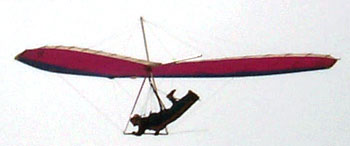 The
fourth reason, that the area is being closed to protect the dogs and
dog owners from injury. I think, really, that is something that should
be determined by the dog owners themselves, that we don't want a government
that protects us because we choose to engage in an activity which
some may consider risky. Indeed, hang gliding is considered by some
a dangerous activity, and we ask that the government not protect us.
Let us assume the risk.
The
fourth reason, that the area is being closed to protect the dogs and
dog owners from injury. I think, really, that is something that should
be determined by the dog owners themselves, that we don't want a government
that protects us because we choose to engage in an activity which
some may consider risky. Indeed, hang gliding is considered by some
a dangerous activity, and we ask that the government not protect us.
Let us assume the risk.
Again, I'd like to thank the GGNRA for the support that it has shown for our sport over the years.
We appreciate it, and we just ask that hard science be produced before there be any closures.
Thank you.
Francine Podenski: I have just a couple of points to make. First of all, I agree with a lot of what's been said here tonight, and I don't have a lot to add, but there are some points that I think may have gotten lost after all this time, because now it's closing in on midnight, and we're not done yet.
Earlier in the evening, I just want to remind the commissioners that there seems to be a lot of question about the validity of the science that's been used to validate these closings, of the proposed closures. And I would really encourage you to, for yourselves, consult a variety of scientists not associated with any of the stakeholders in this room (which might be kind of hard to do, because we've all been asking these scientists). But I think that the repeated reference to "voodoo science", and I know that when I went on to the Web, something I learned that I thought interesting: we keep hearing there's only two coastal colonies of bank swallows left. That may be true, but, according to the information I found on the Web, bank swallows really prefer rivers, they don't really like oceans too much. These are actually odd colonies. So, to say, "there's only two left", is -- we should be saying that, "it's amazing that we have these two strange bank swallow colonies." And the one at Fort Funston has been coming back for decades, and we should be looking at that more as an anomaly, instead of an alarm.
I also would like to emphasize that urban parks are not wilderness areas. I am very pleased -- I was very pleased -- when Golden Gate National Recreation Area was first formed. It seemed like a really good idea. But this is an urban area, this is not a wilderness area, and I think that how the Golden Gate National Recreation Area is managed needs to reflect the community around it, and I believe the enabling legislation and the original agreements require that.
I would really like to see the accessible trail that no longer exists at Fort Funston replaced as soon as possible. I think that one of the biggest tragedies -- and this is not about dogs -- this is about people who can no longer go there. There were quite a number of senior citizens going there regularly, and disabled people, that can no longer use Fort Funston. And that is not legal, actually.
I'd also like to see native plant gardens created in low-traffic areas. I think they're fabulous, but I think to put them in high-traffic areas is a mistake, and a misuse of resources.
Thank you.
My name is Mort Gensberg. I'm a longtime San Francisco resident. I want to thank you all for staying here as late as it is; it's almost bedtime, and particularly thank Mr. Sayres for being here, and the representative from PAWS, thank you both for being here. I really appreciate that. I'm sure everybody else does, too.
This is not a recreational process. I've been walking my dogs out at Fort Funston for almost 40-some odd years now, and in the last three or four years, I don't find myself being... I'm not relaxed, this is a very stressful situation for me. I think that somehow they're trying to take the rug from under us... This is very upsetting, actually.
People don't realize that dogs give us sight, aid our hearing, and companionship -- I mean, the most important things in my life are my dogs -- other than my wife, and my children. [audience laughter]
I'm not exaggerating when I say, walking my dogs is probably the most wonderful thing I do during the day. It's the one thing I do look forward to. I think there's a concern here that we're going to lose this right. I think that this is only the beginning of what I feel is going to be an ongoing process. So, I don't want to come back here again. I'm hoping that somehow we can resolve this thing so that we don't have to have this kind of confrontation again; it's very upsetting.
As far as the swallows are concerned, I love birds, and the birds have been coming back for, my understanding is, for ninety-some odd years... without fences, and with the attendant dogs and people and so on, I mean, after all these years, why are they still coming back?
I rest my case. Thank you.
Renée
Pittin: I am now a resident in San Francisco, but before
I ever moved to the city, I was taken to Fort Funston so that I could
enjoy the spectacular views  of the city and the sea from the windblown vantage point of Fort Funston,
with a plethora of dogs running and playing nearby.
of the city and the sea from the windblown vantage point of Fort Funston,
with a plethora of dogs running and playing nearby.
For
a dog owner or dog lover, Fort Funston is particularly evocative.
There are few urban areas which provide the wide-open space available
at Fort Funston for allowing a dog to run and play, and to meet and
socialize with other dogs. Because it is open and broad, the
dogs do not feel hemmed in, as may occur in small parks or those awful
ghettos called "dog runs." For myself, the sight of my eleven-year-old
dog lying on the dune, enjoying the sun and breeze like a sunbather
on the beach, fills me with pleasure, and makes me thank my lucky
stars that I'm in San Francisco, and at Fort Funston. 
Humans learn humanity very slowly. It is only now being recognized that the love and care that pets engender in people can give people the very will to live. It is also now recognized that those who care for pets have a responsibility to give them a reasonable quality of life, including the opportunity to run, to play, and to socialize with their own species. Fort Funston is on the cutting edge of this realization and this reality. In an era of road rage, aggression and seemingly increasing danger and negative communication, Fort Funston represents a solution and a move forward, in its nevertheless decades-old recognition of the importance of these bonds between people and their pets.
In
seeking to close these latest sections of Fort Funston, there is hardly
a reason which hasn't been run up the flagpole: maintenance, safety,
erosion, protection of bank swallows… While it is certainly true that
maintenance, safety, etc. would be a lot easier with no 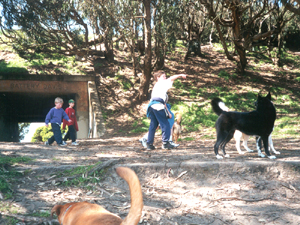 people
in the park at all, that disregards the purpose of the park, and of
the recreational mandate. Given the fact that even the bank swallows
are moving away from the "protected" areas, it is clear that the GGNRA
has to reexamine its options and its priorities.
people
in the park at all, that disregards the purpose of the park, and of
the recreational mandate. Given the fact that even the bank swallows
are moving away from the "protected" areas, it is clear that the GGNRA
has to reexamine its options and its priorities.
The GGNRA has the opportunity to take the high road here. It can (and must) honor its enabling legislation, which forefronts its recreational purpose. Fort Funston is a park loved, admired, and used by thousands and thousands of dog walkers, dog lovers, whale watchers, hikers, hang gliders and others, day after day.
Please respond to the users of this park: Keep Fort Funston open, fully open, to the public.
Thank you.
Hi, my name's Claudia Kawczynska, and my comments tonight deal with the public process, or perhaps, more accurately, the lack thereof. I am the chairperson of the Berkeley Waterfront Commission, and I also served on a task force for dog use in parks in that city. I have studied and worked on dog issues for seven years, and during that time I have learned the importance of listening to the public.
Public hearings should go beyond their legal requirement to be convened, and should be the opportunity for policy makers and advisors, such as yourself, to not just meet the public who will be affected by your recommendations, but also to learn from those in attendance at your meetings. You need to be open to their legitimate concerns and their suggestions, and I hope tonight you will be doing that.
I am also aware that, in order for the process to be as open and as fair as possible, to be true participatory, democratic process, the major user groups need to be consulted with during all phases of a process, not just during those times when it is required by the letter of the law to do so.I'm also well aware that other groups, including the Audubon and the Sierra Clubs, seem to be privy to the decision-making process within public agencies, and their opinions seem to hold more weight than other park user groups.
Dog
user groups have historically been excluded  from
the planning process, not just here, but in other areas. Signs go
up, fences go up, and all the dog people are expected to obey
the new law of the land simply because it has been so posted. Well,
if all of life were so simple, wouldn't that work well for everyone.
But the best way to ensure that a new land use policy is respected
is for the people who are most affected by it to be directly involved
in all stages of development of that policy.
from
the planning process, not just here, but in other areas. Signs go
up, fences go up, and all the dog people are expected to obey
the new law of the land simply because it has been so posted. Well,
if all of life were so simple, wouldn't that work well for everyone.
But the best way to ensure that a new land use policy is respected
is for the people who are most affected by it to be directly involved
in all stages of development of that policy.
Most people who use Fort Funston, and other GGNRA lands, are deeply concerned about the environment, about sustaining the habitat for the swallow and other species, and they believe that there is a better way to work towards achieving common goals, and that is to work together on these issues. They don't want to be excluded from the process, and they bring enormous amounts of energy and talents to the challenges that are before you tonight. Please give them your full attention and your due considerations in your deliberations.
Thank you.
Good evening. My name is Joseph Stroman and I'm speaking against the proposed closure at Fort Funston.
Including the proposed 12 acre closure, a full one quarter of the park will be off-limits to the public. None of the areas which have been closed have ever been reopened, with the exception of the portion of Sunset trail that was closed and reopened this year.
It is important to remember that Fort Funston is an urban recreation area, not a nature preserve. And bit by bit the public is being denied access. As an urban recreation area, it is the perfect place for the off-leash exercise of dogs. To deny us access to one of the most beautiful parts of the park with its panoramic views is uncalled for.
I'm glad that Golden Gate Park isn't under the GGNRA -- they would close it, remove the plants, and reinstitute sand dunes there.
I strongly urge this commission to recommend a denial of the proposed closure at Fort Funston.
Thank you.
My name is Jeffrey Ward. I've spoken to you previously on related issues.I'm a member of the Fort Funston Dog Walkers, I'm a founder of the San Francisco Dog Owners Group, I'm a member of a bird-watching family, and I'm a proud alpha male to my three Weimeraners who need a lot of exercise.
I was trained as a scientist. In fact, I taught ethology at Northwestern University. During my education, I was taught to respect some basic principles of scientific research, and I was taught particularly that the application of scientific research requires special care, and I have been appalled by the lack of such care on the part of the GGNRA.
I'm going to curtail my comments for your health and well-being, but let me just say that, for example, in 1995 large areas of Fort Funston were closed to all park users. These closures were justified using various reasons -- everything from erosion control to bank swallow habitat -- and the dog walkers agreed to the closures because, as animal lovers, we were very sympathetic to the conservation movement. During the period of these closures, the bank swallow population began to decline. The population has recently moved out of the protected areas, and as a result the Park Service has proposed some very extensive park closures, extending far to the east and south of the original bank swallow colony. I've even heard, for example, GGNRA staff members tell park visitors that this is one of only two bank swallow colonies in California, when of course we know it's only one of two seaside bank swallow colonies; bank swallows, as their name implies, prefer river and stream banks.
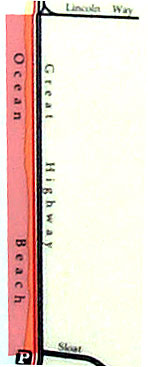
This kind of poor science is not new. For example, in 1996 the GGNRA closed Ocean Beach, you'll probably remember that, to off-leash recreation, supposedly to protect the threatened Snowy Plover. I've looked at the studies associated with this closure, and the report of Daphne Hatch, a GGNRA wildlife biologist, found no statistical relationship between the presence of off-leash dogs on the beach and the prevalence of the Snowy Plover, and it also found that there was very little interaction between the dogs and the birds. Yet the report concluded by recommending the ban on off-leash recreation, which was very quickly implemented.
Now the dog owners of Fort Funston, who have been enjoying this park literally for generations, are being subjected to bad science and an overblown zeal for environmental nostalgia. The most pernicious evidence of this is this native plant movement. I don't doubt the environmental commitment of GGNRA employees or the native plant advocates, nor do I doubt their good intentions, but they appear to want to have exclusive claim on the park.
I would just like to say that the primary expert on the science in this matter was the biologist responsible for bank swallow protection in California, and that biologist did not agree with the Fort Funston closures. In fact, this biologist recommended exactly the same sorts of closures that had been proposed by the dog walking community at Fort Funston.
Enough said. Thank you very much.

For those of our clients who are able to take their dogs for walks, Fort Funston is an ideal location, especially for those too frail to keep up with their dogs on leash. Additionally, as I said, our clients are low income people, often unable to work and often isolated. So Fort Funston offers opportunity for human as well as canine contact. Unfortunately some of our clients can't walk their dogs themselves. For these clients we provide dogwalkers. Many of these dogwalkers use Fort Funston because its an ideal place for those dogs who are homebound with their guardians. It gives them an opportunity to get good exercise.
We have testimonial after testimonial about the importance of companion animals in the lives of our clients. Some even have said their dog is the reason they are still alive. Therefore on behalf of our 350 clients, 300 volunteers and 6,000 donors I urge you to oppose permanent closure.
Thank you.
 I'm
Dr. Karin Hu and I teach a Scientific Methods course at City
College. This semester I'm using the GGNRA proposal to demonstrate
the national epidemic of scientific illiteracy. I agree with the prior
speakers protesting the GGNRA proposal.
I'm
Dr. Karin Hu and I teach a Scientific Methods course at City
College. This semester I'm using the GGNRA proposal to demonstrate
the national epidemic of scientific illiteracy. I agree with the prior
speakers protesting the GGNRA proposal.
The proposal discusses the "invasion" of non-native species, i.e. ice plant, and the development of native plant habitats. As discussed earlier, there is no scientific evidence showing that ice plant is detrimental to the bank swallows.
Tonight,
I want to focus on this issue of native and non-native plants. I like
California native plants. I regularly visit wildflower havens such
as Edgewood, the Matt Davis trail on Mt. Tam, Chimney Rock at Point
Reyes. I plant California natives in my backyard. I'm a California
native, my roots being planted in California more than 150 years ago.
But I'm troubled when I see it implied that "native is good," simply
because it is native, and that non-native is bad, that "exotics" need
to be evicted simply because they are non-native. Not all natives
are good. For example, the 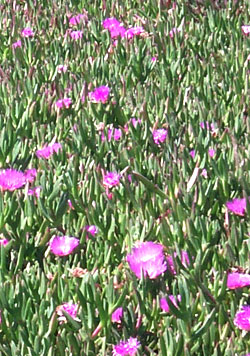 majority
of insect pests are native. On the other hand, there have been some
enormous benefits from non-natives. For example, 99% of our crops
are non-native. All livestock except turkey are non-native. And no
doubt, many of the good people in this room are non-native. The ice
plant at Fort Funston is also non-native.
majority
of insect pests are native. On the other hand, there have been some
enormous benefits from non-natives. For example, 99% of our crops
are non-native. All livestock except turkey are non-native. And no
doubt, many of the good people in this room are non-native. The ice
plant at Fort Funston is also non-native.
What are the benefits of ice plant? It's breath-taking in the spring and green all year around. It's robust and doesn't require maintenance. Ice plant keeps the sand from blowing around. It provides a safe landing area for hang-gliders. In sum, ice plant works for this park.
I don't bring my dogs to Edgewood, Mt. Tam, or Chimney Rock. It's not appropriate. And while ice plant is not appropriate for wildlife areas, Fort Funston is not a wildlife area. This is San Francisco, an urban area. Evicting ice plant to construct fragile native plant developments is not appropriate. Commissioners, please don't allow Fort Funston to become a nature exhibit behind fences.
My
name is Dr. George Paphitis. I have lived in San Francisco
since 1981 and have frequently visited Fort Funston with my dogs.
I have always appreciated the sights, sounds, smells of the sea and
wind that this special place has to offer. I enjoy the unfettered
off-leash activities of my dog with his canine friends, and relish
the spectacular sunsets 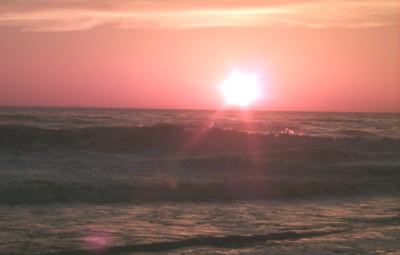 this
venue offers. But I am disappointed that one third of the site has
been, since 1995, closed off to the public on the pretext of safety
and environmental concerns.
this
venue offers. But I am disappointed that one third of the site has
been, since 1995, closed off to the public on the pretext of safety
and environmental concerns.
While I agree that the bank swallows need some protection, and that native plants may require some special consideration, the draconian measures proposed and implemented by the National Park Service which they justify with faulty scientific evidence far exceeds that which is necessary to accomplish these goals.
The National Park Service has lost sight of the purpose of this space as an urban recreational area. A place for people to recreate with their friends and animal companions. In conclusion, if the National Park Service cannot or will not accomodate the wishes of the majority of Fort Funston users, I would fully support the efforts of those San Francisco citizens who would reclaim the land from the federal government and return it to city control. This is an option, I understand, which was included in the original enabling legislation for GGNRA. Thank you.
There were many more speeches from the GGNRA meeting!
To
First Section of Fort Funston Forum